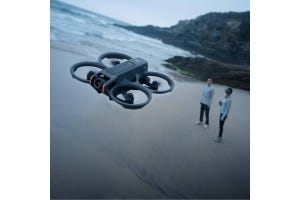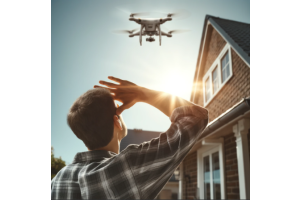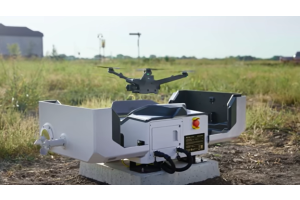
When three kids were stuck in the rising Tuckaseigee River in North Carolina, Jackson County Sheriff's Office used a drone equipped with FLIR (Forward Looking InfraRed) to lead rescuers to them.
In Forrest County, Mississippi, the state’s Emergency Management Agency used their drone’s thermal imaging camera to locate and save a kayaker who had drifted 10 miles through a remote park into a cold night after missing her exit point.
A teen called up the Nottinghamshire Police minutes before midnight telling them that he was sick but didn’t know where he was - but the police found him shortly after launching their drone and got him the help he needed.
Heartwarming stories like these renew our faith not just in humanity, but also in the transformative potential of the technology that enables the feats.
Drones with thermal cameras have revolutionized diverse industries, unlocking new possibilities and capabilities. They can effortlessly detect heat signatures, providing accurate and cost-efficient temperature readings of various areas like commercial rooftops, wildfires, and solar plants.
In the past, such tasks required expensive manned aircraft and time-consuming scheduling. However, with thermal drones, certified drone pilots trained in thermography can deliver the same level of data within minutes.
These remarkable devices combine the maneuverability of drones with the precision of thermal sensors to navigate challenging environments and collect precise temperature data from tall roofs and large industrial sites.
In this blog, we explore the potential, advantages, applications, and future prospects of thermal imaging in drones, showcasing its transformative impact on various industries.
Thermal Imaging 101: What It Is, And How It WorksLiDAR (Light Detection and Ranging
Let’s first take you back to science class.
Definition and Basic Principles of Thermal Imaging
At its core, thermal imaging involves the detection and visualization of heat energy. It relies on the sensing of infrared radiation (IR) emitted by objects in the form of heat waves, which fall within the wavelength range of 1 to 14 micrometers on the electromagnetic spectrum.
Unlike visible light, which can be perceived by the human eye, infrared waves are invisible to us. However, thermal cameras can capture and translate these waves into images that reveal variations in temperature.


Image Source: Ametek
Thermal cameras operate by utilizing a special lens that allows IR frequencies to pass through. The radiation then travels through a thermal sensor and an image processor, resulting in the generation of a thermal image. To enhance interpretation, temperature variations are often color-coded. Colder temperatures are typically represented by shades of blue, purple, and green, while warmer temperatures appear as shades of red, orange, and yellow.
Comparison with Other Imaging Technologies
Thermal imaging differs from other imaging technologies, such as visible light cameras, in terms of the information it captures. While visible light cameras rely on the reflection and absorption of light to create images, thermal cameras directly detect the heat emitted by objects. This fundamental distinction allows thermal imaging to provide unique insights and capabilities.
Unlike visible light cameras, thermal cameras can "see" in complete darkness since they rely on heat signatures rather than ambient light. This feature makes thermal imaging particularly valuable in low-light or nighttime conditions. Furthermore, thermal imaging is less affected by visual obstructions like smoke, fog, or dust particles, enabling it to penetrate through such obstacles and provide clear images.


A horses temperature distribution -together with surroundings – as seen with thermal imaging. Source: InfraTec
Another advantage of thermal imaging is its ability to detect heat disparities and temperature variations across large geographic areas. By capturing heat signatures from above, drones equipped with thermal cameras can create detailed heat maps. These maps can reveal valuable information about hotspots and cold spots, allowing for effective analysis and decision-making.
Overall, thermal imaging provides a unique perspective by visualizing temperature differences, enabling the detection of heat-emitting objects or anomalies that may not be apparent with other imaging technologies. This makes thermal imaging an invaluable tool in various industries, especially when combined with the mobility and accessibility of drones.


Drone photo by Cosy Thame showing heat loss in British homes. Source: BBC
In the next sections, we will explore the advantages of drones in thermal imaging, the diverse applications of thermal imaging in drones, real-life case studies, as well as the challenges and future prospects of this technology.
Overview of drones and thermal camera technology – and its applications
Thermal drones are quickly becoming a widespread tool for detecting heat signatures, offering accurate and cost-efficient temperature readings of commercial rooftops to crop fields and nature reserves. Professional drone pilots certified in thermography can deliver the same level of data that previously needed loads of logistics in a couple of minutes.


Slough Borough Council uses thermal imaging cameras to identify immigrants illegally living in sheds and garages Source: Bluesky International, as published on DailyMail
Thermal cameras can capture thermal information over large geographic areas, enabling the production of detailed heat maps. Drones equipped with thermal cameras have a special lens that allows infrared frequencies to pass through. The thermal radiation then travels through a thermal sensor and an image processor, delivering an actual thermal image.
Factors such as an object's reflectivity, transparency, surface conditions, air temperature, weather, humidity, camera distance and angle, and the smoothness or roughness of the target surface can influence a drone's thermographic reading.
Benefits of using drones for thermal imaging
1. Mobility and accessibility in hard-to-reach areas
Drones equipped with thermal cameras offer exceptional mobility and accessibility in hard-to-reach areas. They can maneuver difficult environments like tall roofs and large industrial sites, detecting hot and cold spots, collecting precise temperature data, or even locating individuals wept away by raging rivers in the dead of night - like was the case for Winnipeg firefighters responding to a distress call at the Assiniboine River where they rescued the victim at 2:30 am. By using drones, pilots can maintain a comfortable and safe distance from the action while obtaining valuable thermal imaging information.
2. Rapid deployment and efficient data collection
Compared to traditional methods, drones provide rapid deployment and efficient data collection capabilities. With thermal drones, professionals can quickly deploy the technology to gather real-time thermal data over vast areas. This significantly reduces the time required for data collection and analysis, enabling faster decision-making and response in critical situations.


Thermographic image (left) with the corresponding RGB image (right) of inner-city buildings looking for weak points. Source: Karlsruhe Institute of Technology (KIT)
3. Cost-effectiveness compared to traditional methods
Drones equipped with thermal cameras offer a cost-effective alternative to traditional methods of thermal imaging. In the past, acquiring thermal data often involved expensive manned aircraft and lengthy scheduling processes. By using drones, businesses and organizations can achieve the same level of data accuracy and quality at a fraction of the cost. The affordability and accessibility of thermal drones make thermal imaging technology more accessible to a wider range of industries and applications.


Drones with thermal cameras are used by scientists within the Texas A&M University System to detect sick livestock at a feedlot in the Texas Panhandle. Image Source: Texas A&M
Applications of Thermal Imaging in Drones
Thermal imaging technology has found a powerful ally in drones, revolutionizing various industries and providing unprecedented capabilities. Drones equipped with thermal cameras have opened up new possibilities in several applications, enhancing efficiency, accessibility, and data collection. Let's explore some of the key applications of thermal imaging in drones:
1. Search and Rescue Operations
One of the most critical applications of thermal imaging in drones is search and rescue operations. Drones equipped with thermal cameras can quickly locate missing persons in various environments. By detecting body heat, these drones can cover vast areas and provide real-time intelligence to rescue teams. With their ability to deploy rapidly and navigate challenging terrains, drones significantly reduce the time it takes to perform successful search and rescue missions. Going by DJI’s drone rescue map that tracks rescue incidents around the world, over 900 lives have been saved across 39 countries using drones.


Photo by Iewek Gnos on Unsplash
Additionally, thermal imaging in drones aids in identifying heat sources such as fires. By detecting hotspots, firefighters can gain valuable insights and assess the intensity of a fire, even in smoky or poorly lit conditions. This capability not only helps in planning efficient firefighting strategies but also ensures the safety of personnel by keeping them at a comfortable distance from the fire.
2. Building Inspections and Infrastructure Maintenance
Thermal imaging drones play a crucial role in building inspections and infrastructure maintenance. They are capable of detecting energy leaks and insulation problems in buildings, allowing for timely repairs and improvements. By identifying areas of heat loss, thermal imaging helps optimize energy efficiency and reduce energy consumption.
Moreover, drones equipped with thermal cameras can identify structural issues and potential risks in buildings and infrastructure. By capturing detailed heat signatures, these drones can detect anomalies that might indicate structural weaknesses or areas at risk of failure. This enables proactive maintenance and ensures the safety and integrity of structures.
3. Agricultural Monitoring and Crop Management
Thermal imaging in drones has transformed agricultural practices by enabling efficient monitoring and crop management. Drones equipped with thermal cameras can assess plant health by capturing temperature variations, which can indicate stress or disease. This information helps farmers make data-driven decisions regarding irrigation, fertilization, and pest control, leading to improved crop yield and reduced resource wastage.
Additionally, thermal imaging drones can detect irrigation issues by identifying areas with inconsistent heat signatures, indicating insufficient or excessive water distribution. By providing real-time data on crop health and irrigation, drones empower farmers to optimize their farming practices and maximize productivity.


Images from an Ecuador potato field. (A) Potato crop field in where images were collected. (B) Drone with DJI Wookong-M autopilot used for data collection. (C) Resulting temperature image at 2 cm spatial resolution. Source: Danilo Yanez and Emile Faye
4. Wildlife Conservation and Environmental Monitoring
Thermal imaging drones play a crucial role in wildlife conservation and environmental monitoring. These drones enable researchers and conservationists to track animal populations and behavior by detecting their heat signatures. Through aerial survey of large areas, drones can collect valuable data on animal movements and habitat usage, aiding in wildlife management and protection efforts.
Furthermore, thermal imaging drones are invaluable in monitoring changes in ecosystems and identifying illegal activities. They can detect anomalies in heat signatures, such as illegal deforestation or poaching activities. That way, the drones equipped with thermal cameras enhance the effectiveness of conservation efforts and help protect our natural resources.
In conclusion, thermal imaging in drones has unleashed a wide range of applications across various industries. From search and rescue operations to building inspections, agricultural monitoring, and wildlife conservation, the power of thermal imaging combined with drone technology is transforming the way we operate and solve complex challenges. With ongoing advancements and future innovations, the potential of thermal imaging in drones is only expected to expand, opening up new frontiers for exploration and problem-solving.
Case Studies and Success Stories
To bring all this around, let’s look at some cases that have made the news from around the world:
Rescuing Dementia-stricken Elderly Woman from Woodland Chill
In a breathtaking turn of events, a missing 83-year-old pensioner, afflicted with dementia, was saved by a police drone equipped with thermal imaging. The remarkable drone quickly located the elderly woman huddling for warmth in a wooded area near a storage yard. Worries over her frail condition intensified due to dropping temperatures that evening.
Within an hour of deployment, the drone's thermal camera pinpointed the distressed pensioner, enabling ground officers to swiftly reach her. Thanks to the drone's ability to cover vast areas, authorities efficiently searched for heat signatures and swiftly brought the shivering woman to safety. Had it not been for this life-saving intervention, the outcome could have been tragic.
As the drone hovered in the sky directly above the woman, it maintained its position until officers arrived at the scene – with the imagery being used to guide the officers to her. Authorities reported that she had endured the elements for over five hours, enduring exhaustion and discomfort due to the chilling weather conditions.
Special Insp Guy Sanders, the skilled pilot behind the rescue drone as reported by The Sun, expressed immense relief, stating, "I'm really glad we found her when we did." Wiltshire police department owns two DJI Inspire 1 drones that have the capability to be fitted with either a high-definition (HD) camera or a thermal imaging camera. This gives them the option to use either camera type based on the specific needs of a given situation or operation.
Battling A Wildfire in Cleburne, Texas
In Cleburne, Texas, a wildfire threatened nearby houses and posed challenges for firefighters due to limited ground visibility and communication issues. However, the deployment of the M30T thermal drone proved to be a game-changer. With its thermal camera, the drone provided real-time aerial awareness to the incident commander, enabling them to monitor the fire's size, location, and direction. It also identified a spot fire igniting in the woods ahead of the fireline and helped direct firefighters to specific locations under threat. The thermal drone greatly enhanced the efficiency and safety of the firefighting operation, making it easier to contain and extinguish the wildfire.


Image Source: DJI
Additionally, the use of DJI FlightHub 2 software further improved firefighting efficiency. The software allowed the team to create a new orthomosaic map of the fire in minutes, overlaid on satellite maps, providing up-to-date information for emergency teams. The laser rangefinder on the M30T drone helped delineate the fire's boundaries by dropping PinPoints, aiding communication and directing resources effectively.
The software's measurement and Live Annotation tools also enabled post-fire analysis. By leveraging the thermal drone and advanced software, the incident commander and the team achieved quick decision-making, accurate mapping, and effective communication, enabling them to bring the wildfire under control and put it out in just four hours.
Saving Grace in the Grass: Protecting Baby Deer from Tragic Mowing Accidents
Every year, countless baby deer face a heartbreaking fate as they are unintentionally killed by mowers while hiding in tall grass. The pressing problem of protecting these vulnerable fawns has now found a remarkable solution in thermal drone technology. Innovators, conservationists, and commercial drone pilots have teamed up to deploy thermal drones, successfully preventing these tragic accidents.


Photo by Vincent van Zalinge on Unsplash
The breeding season of female deer clashes with farmers' need to mow meadows, creating a perilous situation. The tiny figures of baby deer tucked away in tall grass make them nearly impossible for mower operators to spot, and the fawns' instinct to remain still exacerbates the challenge. Disturbingly, in Germany alone, an estimated 90,000 fawns fall victim to mowing machinery each year, with similar numbers seen across Europe.
To tackle this issue, German association Flugmodus e.V collaborated with a drone supplier to develop wildlife protection drones. Equipped with thermal and visual cameras, these drones, specifically the Mavic 2 Enterprise Advanced (M2EA), swiftly identify fawns hidden in grassy "hotspots." The thermal camera identifies the heat signatures, while the visual camera aids a ground search team in locating the fawns, enabling their safe relocation.


Image Source: DJI
Thanks to the implementation of these thermal drones, the once arduous and ineffective manual method of checking fields for nests is being revolutionized. This life-saving technology significantly reduces the time and cost associated with this task, ensuring the well-being of the fawns and the financial stability of farmers. Additionally, it helps prevent the environmental and legal consequences that arise from inadvertently killing these vertebrate animals.
The success of drone wildlife protection initiatives has already been demonstrated, with hundreds of fawns saved during the harvest season in Switzerland alone. The promising results have garnered recognition from the esteemed École Polytechnique Fédérale de Lausanne, which has hailed the efforts as 100% effective. This breakthrough not only safeguards baby deer but also offers hope for protecting various other wildlife species in precarious situations.
Challenges and Limitations
While thermal imaging technology in drones has brought numerous advantages and revolutionized various industries, it also faces several challenges and limitations that need to be addressed. These limitations primarily revolve around weather conditions, image interpretation, and false positives/negatives. However, ongoing research and development efforts are being made to overcome these challenges.
- Weather Conditions
One of the significant limitations of thermal imaging technology in drones is its susceptibility to weather conditions. Adverse weather, such as heavy rain, fog, or snow, can affect the accuracy and reliability of thermal imaging. Precipitation and atmospheric conditions can interfere with the thermal camera's ability to capture and interpret heat signatures effectively. In such conditions, the thermal images obtained may be distorted or unclear, making it difficult to derive meaningful insights.
To overcome this limitation, researchers are exploring advanced techniques to improve the performance of thermal imaging in adverse weather conditions. These techniques may include the development of algorithms that compensate for weather-related distortions or the use of additional sensors to enhance the overall image quality.
- Image Interpretation
Interpreting thermal images captured by drones can be a challenging task. Thermal images are typically represented by color-coded temperature gradients, with warmer temperatures shown in shades of red, orange, and yellow, and colder temperatures shown in shades of blue, purple, and green. However, accurately interpreting these color-coded images requires expertise and training.
Differentiating between relevant heat signatures and background noise or false positives/negatives can be a complex process. There is a risk of misinterpreting thermal patterns or failing to detect critical information due to limited training or experience. In scenarios where time is crucial, such as search and rescue operations, misinterpretation can have severe consequences.
Efforts are being made to address this challenge through the development of advanced image processing algorithms and training programs for drone operators – like the DSLRPros Advanced UAS Operator Training Course. These initiatives aim to improve the accuracy and reliability of image interpretation, reducing the chances of misdiagnosis or missed information.
- False Positives/Negatives
Thermal imaging in drones may also be prone to false positives and false negatives. False positives occur when non-target objects or sources generate heat signatures that are mistakenly identified as potential anomalies or areas of interest. False negatives, on the other hand, refer to instances when actual heat signatures or anomalies go undetected.
False positives can lead to unnecessary actions or resource allocation, while false negatives can result in missed opportunities for intervention or detection of critical issues. These false readings can be caused by various factors, including environmental conditions, equipment limitations, or the presence of reflective surfaces.
To mitigate false positives and negatives, ongoing research focuses on refining algorithms and calibration processes to improve the accuracy of thermal imaging systems. Machine learning techniques and artificial intelligence can be employed to train algorithms to distinguish between genuine heat signatures and false readings more effectively.
Future Prospects and Innovations
So what does the future look like for thermal drones?
Enhanced Resolution and Image Quality
One of the key areas of focus for future advancements in thermal imaging drones is enhancing the resolution and image quality. Higher-resolution thermal cameras would allow for more detailed and precise heat mapping, enabling users to detect even subtle temperature variations with greater accuracy. With improved image quality, thermal drones can provide more valuable insights and data for applications such as building inspections, infrastructure maintenance, and environmental monitoring.
Advanced Image Processing and AI Capabilities
Another area of interest is the development of advanced image processing algorithms and artificial intelligence (AI) capabilities. By leveraging AI, thermal imaging drones can not only capture thermal data but also analyze it in real-time, providing instant insights and actionable information. AI algorithms can enable automated detection and classification of heat signatures, making the analysis process faster and more efficient.
This integration of AI with thermal imaging technology opens up possibilities for autonomous drones that can identify and respond to specific thermal patterns or anomalies, further enhancing their capabilities in applications like search and rescue operations and security surveillance.
Sensor Fusion with Other Technologies
Furthermore, there is great potential for integrating thermal imaging with other sensor technologies, such as LiDAR (Light Detection and Ranging) and multispectral sensors. Combining these different sensors can provide a more comprehensive understanding of the environment by capturing not only thermal data but also 3D spatial information and additional spectral data.
For example, integrating thermal imaging with LiDAR can enable the creation of detailed 3D thermal maps, which can be valuable for applications like urban planning, environmental monitoring, and precision agriculture.
Overcoming Limitations and Challenges
In addition to hardware advancements, ongoing research efforts are focused on overcoming the limitations of thermal imaging technology in drones. Challenges such as adverse weather conditions, image interpretation, and false positives/negatives are being addressed through improved sensor calibration, better algorithms, and the development of robust data processing techniques. By tackling these challenges, thermal imaging drones can become even more reliable and effective in diverse operating environments.
Exploring New Research Areas
As thermal imaging technology continues to evolve, new research areas are emerging. For example, researchers are exploring the use of hyperspectral thermal imaging, which combines thermal and spectral data to capture a wider range of information. This could lead to breakthroughs in areas like medical imaging, precision agriculture, and environmental monitoring.
Discover a wide range of thermal drones for your unique needs at DSLRPros. Have questions? Speak to our support team today via phone through (877) 299-1075 / (213) 262-9436 or reach us at support@DSLRPros.com.


Photo by Ian Usher on Unsplash





